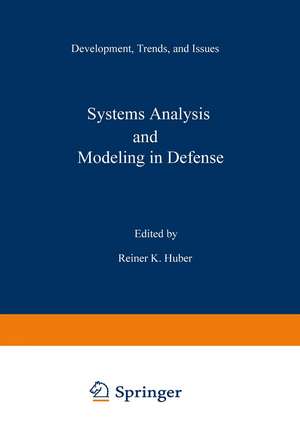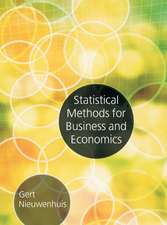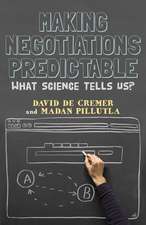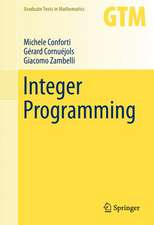Systems Analysis and Modeling in Defense: Development, Trends, and Issues
Editat de R. Huberen Limba Engleză Paperback – 12 feb 2012
Preț: 677.67 lei
Preț vechi: 797.25 lei
-15% Nou
Puncte Express: 1017
Preț estimativ în valută:
129.70€ • 134.88$ • 108.53£
129.70€ • 134.88$ • 108.53£
Carte tipărită la comandă
Livrare economică 15-29 martie
Preluare comenzi: 021 569.72.76
Specificații
ISBN-13: 9781461593720
ISBN-10: 1461593727
Pagini: 932
Ilustrații: XVI, 914 p.
Dimensiuni: 170 x 244 x 49 mm
Greutate: 1.45 kg
Ediția:Softcover reprint of the original 1st ed. 1984
Editura: Springer Us
Colecția Springer
Locul publicării:New York, NY, United States
ISBN-10: 1461593727
Pagini: 932
Ilustrații: XVI, 914 p.
Dimensiuni: 170 x 244 x 49 mm
Greutate: 1.45 kg
Ediția:Softcover reprint of the original 1st ed. 1984
Editura: Springer Us
Colecția Springer
Locul publicării:New York, NY, United States
Public țintă
ResearchCuprins
Section 1 Introduction.- Some Important Issues in Allied Command Europe to which Analysis Could Contribute.- Some Issues in Defence Systems Analysis and Modelling.- Section 2 New Model Development.- Findings of Workshop A.- 2.1 New Land/Air Warfare Models.- Analyse de la Dynamique d’une Confrontation Conventionnelle Est-Ouest en Relation avec la Dialectique du Desarmament.- Central Region Conflict Dynamics Model (CRCDM).- Defence Dynamics — Predictions of War Outcomes and Evaluation of Force Structure.- CORDEF: An Army Corps Simulation.- The Land Operations Model — An Application of System Dynamics for Modelling Land Combat on the Division Level.- VECTOR-2 Land/Air Campaign Model.- Summary of a Verification Study of VECTOR-2 with the Arab-Israeli War.- Canadian Land War Gaming.- The McClintic Theater Model.- Large Unit Combat Simulation — Corps and Division.- 2.2 Modelling Command, Control, Communications, Intelligence (C3I) and Electronic Warfare.- Structure of Command and Control (C2) Analysis.- The Command and Control Process as a Function of Time.- Methods for Analyzing the Contributions of C3 and C3CM to Military Force Capabilities.- C3 and Combat Simulation — a Survey.- What Influences a Battlefield Command Decision?.- Modelling of Tactical Decision Processes for Division — Level Combat Simulations.- Quantitative Analysis of Intelligence/Electronic Warfare: VECTOR/IEW.- Intelligence and Electronic Warfare Model.- Modelling C3 — A Description of the Command, Control, Communications, Combat Effectiveness (FOURCE) Model.- Test and Evaluation of the Technical Control and Analysis Center at Division (TCAC (D)).- 2.3 Modelling and Analysis of Nuclear and Chemical Weapon Effects.- The IDA Tactical Warfare Model: A Theater-Level Model of Conventional,Nuclear, and Chemical Warfare.- Use of War Games in Analysis of Tactical Nuclear Warfare Doctrine.- Modelling Nuclear and Chemical Effects in a Division/Corps War Game.- Section 3 Modelling Issues and Analysis of Results.- Findings of Workshop B.- 3.1 Empirical Models and Model Foundation.- Can Exercises be Used in Place of Operations in Operational Research?.- A Comparison of Casualty Rates Recorded in a Field Trial and Those Predicted by a Computer Programme.- The Place for Tactically Interactive Field Trials in Data Collection.- Analysis of Opportunities to Engage.- Experimental Evidence of the “Tide of Battle”.- 3.2 Hierarchical Modelling and Aggregation Problems.- US Army Model Improvement Program (AMIP).- Hierarchical Linkup of Attrition and Ammunition Expenditures between Models.- A Self-Contained Hierarchical Simulation Construct.- Aggregation Methods to Represent Small Dismounted Infantry Unit Combined Arms Battles in Division and Corps War Games.- Extensions to Lanchester Theory of Combat.- The Use of a Special Win Factor in Army Corps Simulations as Applied to Attrition Issues.- 3.3 Variance Due to Combat Processes and Model Structure.- Combat Situation Assessment with Respect to Terrain and Tactics.- How Non-Weapon-System Parameters Affect Combat Results.- Structural Variance and other Related Topics Experienced in the SHAPE Armour/Anti-Armour Study.- STOCHADE — A Highly Aggregated and Stochastic Combat Model.- Variance Reduction.- Section 4 Analysis Issues.- Findings of Workshop C.- 4.1 Force Design and Long Range Planning.- Defense Long Range Acquisition Planning — Concepts and Methodology.- Improving the Definition of the Army Objective Force (IDOFOR) — A Methodology Study.- Some Force Structuring and Design Analysis Issues.- Application of aWar Game and an Analytical Decision Model to Planning of Military Structures.- 4.2 Tactics and Operational Concepts.- A Contingency Force Analysis Methodology.- Evaluation de l’Intérêt Stratégique de Zones Particulières.- The MAGIC (Manually Assisted Gaming of Integrated Combat) Model.- Battle.- Modelling the Red Force — Simulating Soviet Responses in Battle.- 4.3 Readiness and Sustainability.- Omnibus — A Methodology for Assessing Force Readiness and Sustainability.- Combat Sustainability Analysis of NATO Center Region TacAir in Support of the U.S. Planning, Programming, Policy and Budgeting Process.- TSAR and TSARINA: Simulation Models for Assessing Force Generation and Logistics Support in a Combat Environment.- Loss Rates and Maintenance Requirements in Wartime.










